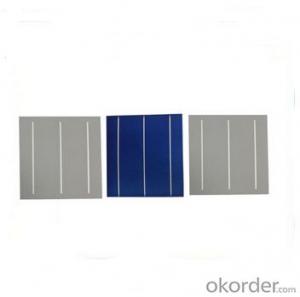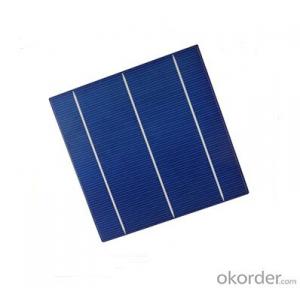Affordable Polycrystalline Solar Cells High Quality 156mm×156mm±0.5mm
- Loading Port:
- Shanghai
- Payment Terms:
- TT OR LC
- Min Order Qty:
- 1000 pc
- Supply Capability:
- 1000000 pc/month
OKorder Service Pledge
OKorder Financial Service
You Might Also Like
Solar Cells:
solar cells, when struck by photons of light from the sun, generates an electrical current which can then be used to power DC or AC electrical loads.
A solar cell is made of silicon. Computer chips are made of this same material. Basically, when light strikes the surface of a solar cell some of it is absorbed into the silicon. This light energy bumps the electrons loose and causes energy to flow
Solar cells is made by solar wafer, it has three categories of solar cell right now, monocrystalline polycrystalline and thin film,These cells are entirely based around the concept of PN junction, which is the critical part of solar module, it is the part that can convert the light energy into electricity, the thickness is from 180um to 200um, with even busbars to conduct electricity, textured cell can decrease diffuse reflection; they are often electrically connected and encapsulated as a module. Photovoltaic modules often have a sheet of glass on the front (sun up) side, allowing light to pass while protecting semiconductor wafers from abrasion and impact due to wind-driven debris, rain, hail, etc. Solar cells are also usually connected in series in modules, creating an additive voltage. Connecting cells in parallel will yield a higher current;With high quality and stable quality. Our Cells can greatly improve the performance of Solar Modules.
Specifications
Format | 156mm×156mm±0.5mm |
Thickness | 210μm±30μm |
Front(-) | 1.4mm bus bars(silver), blue anti-reeecting coating(silicon nitride) |
Back(+) | 2.0mm wide soldering pads(silver) back surface eld(aluminum) |
Efficiency(%) | Pmpp(W) | Umpp(V) | Impp(A) | Uoc(V) | Isc(A) | FF(%) |
17.80-18.00 | 4.33 | 0.53 | 8.159 | 0.633 | 8.709 | 78.44 |
17.60-17.80 | 4.29 | 0.527 | 8.126 | 0.631 | 8.677 | 78.27 |
17.40-17.60 | 4.24 | 0.524 | 8.081 | 0.628 | 8.629 | 78.17 |
17.20-17.40 | 4.19 | 0.521 | 8.035 | 0.625 | 8.578 | 78.08 |
17.00-17.20 | 4.14 | 0.518 | 7.99 | 0.623 | 8.531 | 77.97 |
Features:
High efficiencies up to 16.4%
Proven long term mechanical stability of silicone
Make of highly purified poly silicone
Three bus bars for reduced series resistance and improved module and cell efficiency
Blue anti-reflecting coating ensures improved light absorption and increased efficiency
Acid texturization offers a uniform appearance and virtually invisible crystal structure
Excellent low light behavior for improved energy yield
Solar Cells Advantage:
• High efficiency and stable performance in photovoltaic conversion.
• Advanced diffusion technique ensuring the homogeneity of energy conversion efficiency of the cell.
• Advanced PECVD film forming, providing a dark blue silicon nitride anti-reflection film of homogenous color and attractive appearance.
• High quality metal paste for back surface and electrode, ensuring good conductivity, high pulling strength and ease of soldering.
• High precision patterning using screen printing, ensuring accurate busbar location for ease with automatic soldering a laser cutting.

FAQ
We have organized several common questions for our clients,may help you sincerely:
①What price for each watt?
It depends on the efficiency of the solar cell, quantity, delivery date and payment terms.
②How long can we receive the product after purchase?
In the purchase of product within three working days, We will arrange the factory delivery as soon as possible. The pecific time of receiving is related to the state and position of customers.Commonly 7 to 10 working days can be served.
③Can you provide the peripheral products of the solar panels, such as the battery, controller, and inverter? If so, can you tell me how do they match each other?
Yes, we can, we have two companies for solar region, one is CNBM International, the other is CNBM engineering Co.
We can provide you not only the solar module but also the off grid solar system, we can also provide you service with on grid plant.
④What is your warranty of solar cell?
Our product can promise lower than 0.3% open box crack, we support claim after opening the box if it has crackm color difference or sth, the buyer should give pictures immediately, we can not accept the claim after the solar cell has assembled to solar panel.
• Timeliness of delivery
• ⑤How do you pack your products?
We have rich experience on how to pack the solar cell to make sure the safety on shipment, we could use wooden box or pallet as buyer's preference.
- Q: Can solar cells be damaged by hail or other weather events?
- Yes, solar cells can be damaged by hail or other severe weather events. Hailstones can cause physical damage to the surface of the solar panels, leading to cracks or shattered glass. Additionally, strong winds, heavy rain, or extreme temperatures can also impact the performance and durability of solar cells. It is crucial to consider the weather conditions and take necessary precautions during the installation and maintenance of solar panels to minimize potential damage.
- Q: Can anybody tell me the power supply of the home solar cell?
- Since the power supply of two solar cells panel would be below 500 watts, so if you are not using too much euipment at home at one time, you won't be needing more than 250WATTS
- Q: Can a solar cell be used in commercial buildings?
- The answer is absolutely yes!
- Q: Can solar cells be used for powering internet connectivity?
- Yes, solar cells can be used to power internet connectivity. Solar cells convert sunlight directly into electricity, which can be used to power various devices, including internet routers and modems. This allows for the provision of internet connectivity in remote or off-grid areas where traditional power sources may be limited or unreliable. Additionally, solar-powered internet connectivity can contribute to sustainability efforts by reducing reliance on fossil fuels and lowering carbon emissions.
- Q: How do solar cells handle electromagnetic radiation?
- Solar cells are designed to handle electromagnetic radiation by converting it into usable electrical energy. The materials within the solar cells absorb photons from the sunlight, which in turn generates an electric current. This process effectively harnesses the energy from the electromagnetic radiation and allows solar cells to produce clean and renewable electricity.
- Q: How do solar cells perform in dry desert conditions?
- Solar cells perform very well in dry desert conditions. The abundance of sunlight and low humidity levels in deserts make them ideal environments for solar energy generation. The absence of cloud cover and dust particles allows solar cells to efficiently convert sunlight into electricity, resulting in higher energy production. Additionally, the heat in desert regions can actually benefit solar cells, as higher temperatures can increase their efficiency. Overall, solar cells are highly effective and efficient in dry desert conditions.
- Q: Can solar cells be used to power remote sensing devices?
- Yes, solar cells can be used to power remote sensing devices. Solar cells convert sunlight into electricity, which can then be used to power various electronic devices including remote sensing devices. This eliminates the need for traditional power sources or batteries, making solar cells a reliable and sustainable option for powering remote sensing devices in locations where access to electricity may be limited or impractical.
- Q: How are solar cells made?
- Solar cells are typically made by using a combination of silicon, metal conductors, and anti-reflective coatings. The process involves depositing layers of these materials onto a substrate, which is then cut into individual cells. These cells are then assembled into solar panels, which can convert sunlight into electricity.
- Q: Can solar cells be used to power water pumps?
- Yes, solar cells can be used to power water pumps. Solar cells convert sunlight into electricity, which can be used to power various devices, including water pumps. This is commonly done in remote areas where there is no access to electricity grids or in situations where using solar energy is more cost-effective and sustainable.
- Q: How much electricity can a solar cell generate?
- The amount of electricity a solar cell can generate depends on various factors including the size and efficiency of the cell, the intensity of sunlight, and the duration of exposure. On average, a typical solar cell can generate around 200 to 400 watts of electricity per square meter under optimal conditions.
Send your message to us
Affordable Polycrystalline Solar Cells High Quality 156mm×156mm±0.5mm
- Loading Port:
- Shanghai
- Payment Terms:
- TT OR LC
- Min Order Qty:
- 1000 pc
- Supply Capability:
- 1000000 pc/month
OKorder Service Pledge
OKorder Financial Service
Similar products
Hot products
Hot Searches
Related keywords


























